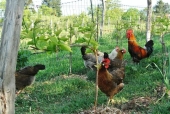








Life is too short, plant a tree for those that follow.




Sometimes the answer is nothing









Sometimes the answer is nothing





 1
1








 1
1









Violet Heart wrote:
I would be hesitant to feed chickens food I think is toxic though: mainly leftover baked goods, if they are of the mainstream, wonderbread category. I used to pick up food from a food bank in Austin, TX for a children's program I ran for homeless kids. All the baked goods were free, and after a while, I realized that lots of them never go bad, scary, as they are so full of preservatives, and have no nutrients whatsoever. I don't think I would give that stuff to a chicken! But maybe some old sourdough bread.
When propanoic acid is infused directly into rodents' brains, it produces reversible behavior changes (e.g. hyperactivity, dystonia, social impairment, perseveration) and brain changes (e.g. innate neuroinflammation, glutathione depletion) that may be used as a model of human autism in rats.




Dr. Denice Moffat & Michael Robison
www.NaturalHealthTechniques.com or
http://www.facebook.com/pages/Elk-Meadow-Farm-Nursery/209184999104914




The first rule of permaculture is you don't talk about permaculture
USDA Zone 7b




Medicinal herbs, kitchen herbs, perennial edibles and berries: https://mountainherbs.net/ grown in the Blue Mountains, Australia




It's time to get positive about negative thinking  -Art Donnelly
-Art Donnelly




nancy sutton wrote:Will chickens actually eat fuzzy comfrey leaves? I see someone shreds and wets them... do they like them that way? Also, is it as bad for chickens' livers as it is for human livers? or is it just comfrey root that is dangerous? I should do research, but thought maybe some has real experience with their chickens and comfrey. TIA
Vic Johanson
"I must Create a System, or be enslaved by another Man's"--William Blake
 1
1








It's time to get positive about negative thinking  -Art Donnelly
-Art Donnelly

|
All of the world's problems can be solved in a garden - Geoff Lawton. Tiny ad:
The new permaculture playing cards kickstarter is now live!
https://www.kickstarter.com/projects/paulwheaton/garden-cards
|




